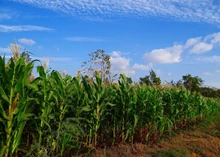
Ravindra Reddy, a cotton farmer in Damera village of Telangana's Hanamkonda district, is overjoyed with the yield of nine quintals of cotton per acre. Last year's yield was limited to about six quintals per acre due to pink bollworm, one of the most damaging cotton pests.
Last year, Reddy claimed that few farmers knew the pink bollworm or its management. This year, the intervention of Louis Dreyfus Company (LDC), a French agricultural and food processing company headquartered in Rotterdam (Netherlands), has helped farmers control the damage.
Following the pink bollworm outbreak in 2021, LDC launched 'Project Jagruthi' for cotton growers in India. It trained over 7,500 farmers in over 30 villages in Punjab, Haryana, Rajasthan, Gujarat, Maharashtra, Telangana, Karnataka, and Andhra Pradesh through workshops. In addition, the company provided them with over 40,000 pheromone traps for pink bollworm management. It gave you eight traps per acre.
"Awareness and pheromone traps have increased per acre yield," said Reddy. Another farmer, Rajeshwara Rao, claims that the pheromone traps in his two acres saved 95% of his crop from pink bollworms. Mergu Rajkumarayya, who has been cultivating cotton for nearly 20 years, says the cost of cultivation is increasing due to rising pesticide and fertiliser costs, which are exacerbated by pink bollworms.
"LDC conducted a series of educational workshops to support cotton farmers in mitigating threats such as pink bollworm and white fly infestations and reduce the cost of cultivation through better farming practices. "Specific methods were demonstrated, as well as technical advice from experts, to reduce yield losses due to pest outbreaks, thereby increasing production and income," says Gangadhara S, LDC's Head of Cotton Research.
"Farmers have responded enthusiastically to the project," said Sumeet Mittal, LDC's Cotton Platform Head in India. We plan to expand the project and reach more farmers. He said that cotton is the backbone of many states' agriculture, and any damage to the crop results in significant losses for farmers. Yogeshwar, a farmer, agrees. "Pink bollworm attack destroys almost three portions of the flower and affects the quality and quantity [of yield]. Farmers earlier incurred huge losses. Early detection and intervention are critical. "LDC played a critical role in preserving yield in our village," he explained.
At an interactive meeting with cotton textile value chain stakeholders in July of this year, Union Minister for Commerce and Industry, Textiles, and Consumer Affairs Piyush Goyal emphasized the role of private players in improving cotton productivity and branding of Indian cotton. He stated that the private sector must contribute to increasing productivity research, farmer education, and branding, with government matching funds. Goyal, who has called for an integrated approach, has stated that the private sector must act in mission mode to strengthen the cotton value chain.











